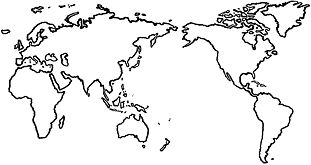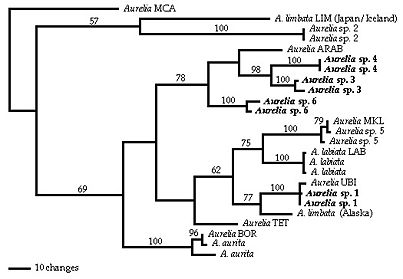User contributions
How to Contribute
There are numerous ways to contribute to The Scyphozoan. You might wish to send a picture, provide samples, correct an error, describe how to identify a jellyfish, summarize geographic distributions, or many things more. Sometimes, a short e-mail including the relevant information sent to mdawson@ucmerced.edu will suffice. However, contributions may be more substantial. For these cases, some instructions are provided below to simplify the procedure for you and for the webmaster. If you are able to send web-pages ready made in the correct format, they will be gratefully received.
Biogeography
- Use this world map template JPEG and save it to your disk.
- Use a suitable graphics program to draw species distributions. Save the modified figure as a JPEG. Please try to include all valid species in a single genus on one map. If there are many species with overlapping ranges, additional maps may be justified in the interests of clarity. Indicate sample locations with color-coded dots and inferred ranges as color-coded polygons (empty or filled). Double-check for errors.
- Write a concise caption explaining the figure in WORD and save as an HTML document. Include citations to the relevant literature, especially those upon which the figure is based. Check for factual, grammatical, and spelling errors.
- Scan the files with up-to-date anti-virus software, then send them as e-mail attachments to mdawson@ucmerced.edu.
- A web-page will be created including the figure and text you sent, a personal credit, and links to relevant pages within The Scyphozoan.
- See a finished example web-page: Aurelia biogeography.
Taxonomy
The format of taxonomic contributions will vary with taxonomic level. At this time, we are most interested in two types of contribution.
- Contributions that summarize the characteristics of higher taxa (Genus-Order). These should be accompanied by generalized diagrams when possible (JPEG format; 40 pixels/cm, 15 cm wide x 18 cm high) .
- Contributions that describe how to measure in detail, and quantitatively when possible, variation among species within genera. Diagrams indicating features and measurements must be included. In time, we hope to include data from such measurements in a searchable database allowing a wide range of comparative morphological and evolutionary analysis. As with other contributions, text should be written concisely in WORD and saved as an HTML document. Please include citations to the relevant literature, especially those from which the information has been abstracted. Check for factual, grammatical, and spelling errors.
- Scan the files with up-to-date anti-virus software, then send them as e-mail attachments to mndawson@ucdavis.edu.
- A web-page will be created including the figure and text you sent, a personal credit, and links to relevant pages within The Scyphozoan.
Browse the taxonomy pages (see the links at the front page) to see some examples including Aurelia and Mastigias.
Please note, this is not a suitable venue for describing new species.
Phylogeny
- Make a JPEG (40 pixels/cm; max 15 cm wide x 18 cm high) of the phylogeny, including measures of statistical support. The phylogeny should be based on published results. Double-check for errors.
- Write a concise caption explaining the phylogeny in WORD and save as an HTML document. Include citations to the relevant literature, especially those upon which the figure is based. Check for factual, grammatical, and spelling errors.
- Scan the files with up-to-date antivirus software, then send them as e-mail attachments to mndawson@ucdavis.edu.
- A web-page will be made including the figure and text you sent, a personal credit, and links to relevant pages within The Scyphozoan.
See an example phylogeny: Aurelia.
Behaviour
Scyphozoans exhibit a wide range of behaviors, although most are poorly documented. We encourage contributions to this category, and hope it will become one of the more rapidly growing sections of The Scyphozoan.
We suggest the following keywords for for classifying contributions, simply as a guide and a management tool. Other contributions are welcome. Annotate contributions with multiple keywords if appropriate.
Migration
- subsection: vertical migration
- subsection: horizontal migration
Rheotaxis, Phototaxis, Thigmotaxis, Chemotaxis, and any other kind of taxis
- Aggregations and swarms
- Reproduction, Competition, Predation
Ecology
Ecological contributions will be diverse. As a starting point, we suggest contributions be considered in the categories below. This is not a comprehensive list. We expect to expand the scope of this section considerably in response to your suggestions and contributions.
- Coastal management
e.g. fisheries, species introductions, blooms
- Habitat
- Community structure
e.g. food webs, species diversity
- Symbioses
e.g. mutualism, parasitism, commensalism
- Predation, competition, etc.
- Life history
Evolution
Evolutionary studies necessarily draw upon other areas of study, including molecular biology, morphology, behavior, ecology, physiology, biogeography, and much more. Evolutionary contributions should therefore discuss changes in such attributes; the current status of the attributes can be described in other sections. Ideally, evolutionary contributions will be given context by discussing transitions in terms of a molecular phylogeny (or a reliable proxy therefore).
Images
Images should be in JPEG format. For the time being, files should be 40 pixels/cm, maximum 15 cm wide, and maximum 18 cm high, and we will adjust the size as required. In time, we will produce a list of file sizes specific to their use on the site. Please insert the appropriate credits into the figure. Scan the files with up-to-date anti-virus software, then send them as e-mail attachments to mndawson@ucdavis.edu.
Notes
Notes
Please note that submitting a contribution does not guarantee its inclusion in the site. The Scyphozoan is intended to be a source of reliable information for a diverse audience. As such, each submission must be correct and easily accessible to people from a wide range of backgrounds. It should be consistent with similar pages already on the site. Although we hope it will not be necessary to check every submission for accuracy and clarity (we simply do not have time), we will reject any that obviously fail to meet the necessary standards (resubmitting a corrected version may be an option). Any details that appear unsubstantiated or debatable must be validated prior to submission (or perhaps included with the appropriate caveats). Remember, once included in the site, the information will be accessible to a very large number of people. If there is an error, it will be there for the world to see and somebody will find it. Worse, though, somebody (perhaps you) will perpetuate it. Please double-check, if not triple-check, all of the information.
Thank you.
Site Contributions
- Bell, Lori J. Coral Reef Research Foundation, Koror, Palau.
- Bolton, Toby. Dauphin Island Sea Lab, Alabama, USA.
- Cartwright, Paulyn. University of Kansas, USA.
- Collins, Allen G. Tierärztliche Hochschule Hannover ITZ, Division of Ecology & Evolution, Hannover, Germany. The Smithsonian, Washington DC, USA.
- Colin, Pat L. Coral Reef Research Foundation, Koror, Palau.
- Daryanabard, Reza. Offshore Fisheries Research Center, Chabahr, Iran.
- Dawson, Michael N. School of Natural Sciences, University of California, Merced, USA.
- Gershwin, Lisa A. James Cook University, Queensland, Australia.
- Graham, William M. Dauphin Island Sea Lab, Alabama, USA.
- Hingston, Martin. Universität Hamburg, Deutschland.
- Jarms, Gerhard. Universität Hamburg, Deutschland.
- Johnson, Jeanette. Kwajalein, Marshall Islands.
- Johnson, Scott. Kwajalein, Marshall Islands.
- Kawahara, Masato. Graduate School of Biosphere Sciences, Hiroshima University, Japan.
- Kennedy, Fergus. Adelphi Environmental, Seeb, Oman.
- Lee, Chao-Chuan. Institute of Animal Prevention and Cure, Tainan, Taiwan, Republic of China.
- Lo, Wen-Tseng. Department of Marine Resources, National Sun Yat-Sen University Kaohsiung, Taiwan, Republic of China.
- Martin, Laura E. School of Natural Sciences, University of California, Merced, USA.
- Mianzan, Hermes. INIDEP, Mar del Plata, Argentina.
- Migotto, Alvaro E. Centro de Biologia Marinha da Universidade de Sao Paulo (CEBIMar-USP), Brasil.
- Morais, Zilda. Instituto Superior de Ciencias da Saude Sul, Monte de Caparica, Portugal.
- Morandini, André C. Departamento de Zoologia, Universidade de Sao Paulo, Brasil.
- Pagès, Francesc. Institut de Ciències del Mar, Barcelona, España.
- Paulay, Gustav. Florida Museum of Natural History, Florida, USA.
- Peach, Meredith. Department of Environmental Sciences, University of Technology, Sydney, Australia
- Pitt, Kylie A. School of Environmental and Applied Sciences, Griffith University, Australia.
- Purcell, Jenny. Shannon Point Marine Center, Western Washington University, USA.
- Raskoff, Kevin A. Biology Department, Monterey Peninsula College, USA.
- Silveira, Fábio L. da. Departamento de Zoologia, Universidade de Sao Paulo, Brasil.
- Smith, Brian.
- Theusen, Erik V. The Evergreen State College, Olympia, Washington, USA.
- Uye, Shin-ichi. Graduate School of Biosphere Sciences, Hiroshima University, Japan.
- Widmer, Chad, Monterey Bay Aquarium, Monterey, USA.
- Wilson, Simon. Adelphi Environmental, Seeb, Oman.
Sample Contributions
- Bell, Lori J. Coral Reef Research Foundation, Koror, Palau.
- Bolton, Toby. Dauphin Island Sea Lab, Alabama, USA.
- Colin, Pat L. Coral Reef Research Foundation, Koror, Palau.
- Daryanabard, Reza. Offshore Fisheries Research Center, Chabahr, Iran.
- Dawson, Michael N. Evolution & Ecology, University of California, Davis, USA.
- Kawahara, Masato. Graduate School of Biosphere Sciences, Hiroshima University, Japan.
- Lee, Chao-Chuan. Institute of Animal Prevention and Cure, Tainan, Taiwan, Republic of China.
- Lo, Wen-Tseng. Department of Marine Resources, National Sun Yat-Sen University Kaohsiung, Taiwan, Republic of China.
- Martin, Laura E. School of Natural Sciences, University of California, Merced, USA.
- Mianzan, Hermes. INIDEP, Mar del Plata, Argentina.
- Migotto, Alvaro E. Centro de Biologia Marinha da Universidade de Sao Paulo (CEBIMar-USP), Brasil.
- Morais, Zilda. Instituto Superior de Ciencias da Saude Sul, Monte de Caparica, Portugal.
- Morandini, André C. Departamento de Zoologia, Universidade de Sao Paulo, Brasil.
- Paulay, Gustav. Florida Museum of Natural History, Florida, USA.
- Pitt, Kylie A. School of Environmental and Applied Sciences, Griffith University, Australia.
- Raskoff, Kevin A. Biology Department, Monterey Peninsula College, USA.
Big THANK YOU to all our contributors!

